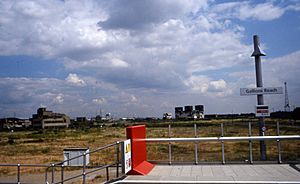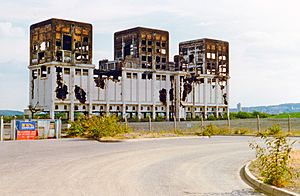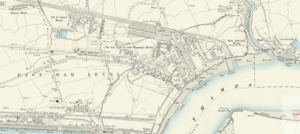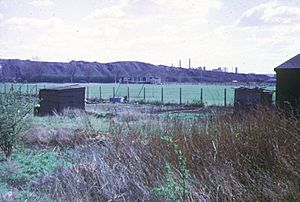Beckton Gas Works facts for kids
Beckton Gasworks was a huge factory in London that made gas for homes and businesses. It also made other useful things like coke from coal. People called it 'the biggest gas plant in the world' or 'the largest gas works in Europe'. It was open from 1870 to 1976. There was also a part that made extra products from 1879 to 1970. The gasworks was located on the north side of the River Thames in East Ham, near Gallions Reach.
Contents
History of Beckton Gasworks
The Beckton Gasworks opened in 1870. It was built by a company called the Gas Light and Coke Company (GLCC). The area and the plant were named Beckton to honor Simon Adams Beck, who was the company's boss. This huge gasworks eventually made gas for most of London north of the Thames. Many smaller gas factories closed down because Beckton was so big.
The gasworks made 'town gas' by heating coal without air. This process is called coal carbonisation. The gas then traveled to central London through a very large pipe, 48 inches (1.22 meters) wide. Later, another pipe was added. To make even more gas, Beckton built a special plant in 1890. This plant made 'carburetted water gas' (CWG). By 1934, this plant could make 40 million cubic feet of gas every day. But most of the gas still came from heating coal.
After World War II, the gasworks was rebuilt and made even better. In 1949, the government took over the plant. It was then owned by the North Thames Gas Board.
In 1949, Beckton was the biggest gasworks in the world. It could make over 119 million cubic feet of gas each day. Over the next 20 years, many improvements were made:
- In 1952, a new CWG plant was built. It could make 20 million cubic feet of gas daily.
- In 1957, a plant was added to use butane gas. This helped supply extra gas during busy times.
- In 1959, a new type of plant started working. It used leftover gases from oil refineries to make town gas.
- In 1968, another large gas-making plant was built. It could make 100 million cubic feet of gas daily. It first used liquid petroleum gases. Then, in 1969, it switched to natural gas from the North Sea.
Making gas from coal became too expensive when natural gas from the North Sea became available. So, the coal gas plant at Beckton closed in 1969. The chemical works that made products from coal also closed that year. Beckton still made town gas using its newer plants until 1976. Beckton was the very last place in the North Thames Gas Board area to switch from town gas to natural gas in homes. This happened on August 29, 1976.
At its busiest, Beckton Gasworks employed 4,500 people. But by the late 1970s, only about 100 workers remained. After it closed, parts of the site were redeveloped.
Where Beckton Gasworks Was Located
The gasworks covered a huge area of 550 acres (223 hectares). It was located south of the Northern Outfall Sewer, between Woolwich Manor Way and the River Thames. The company chose this spot because they could build piers into the Thames. This allowed large ships to unload coal directly from mines in the North-East of England. There were two piers: one for bringing in coal and one for sending out other products. In the 1930s, about a million tons of coal arrived each year. The company even had its own fleet of 17 ships to carry coal.
The gasworks had a very large internal railway system, between 42 and 70 miles (68 and 113 km) long. Some tracks were even raised high up and ran onto the piers. The Beckton Railway connected the gasworks to the main national railway network. This was used for workers traveling to the plant and for sending out products like coal tar. This railway line closed to passengers in 1940 due to bomb damage. The freight line finally closed in 1971.
Beckton Products Works
When people first started making gas from coal, they discovered that many other chemicals could be found when cleaning the gas. So, new ways were found to collect these chemicals. This led to a big new industry in Britain: making products from coal tar and ammonia. In 1876, a nearby company was already making ingredients for disinfectants and dyes from coal tar. The sulphur from the gasworks was used to make sulphuric acid, which other companies needed for products like fertilizers.
Later, the GLCC decided to process these by-products themselves. They built a special chemical factory called Beckton Products Works in 1879. It was the largest factory of its kind in the UK, maybe even the world. Besides millions of gallons of road tar, it made many other chemicals. These included things like phenol (used in plastics), creosote (for wood preservation), benzene (a solvent), and ammonium sulphate (a fertilizer). Since this factory depended on the by-products of gas making, it couldn't last long once natural gas arrived. The last train carrying chemical products left the works on June 1, 1970.
Beckton Alps
The piles of waste from the gasworks were jokingly called Beckton Alps. They used to cover a large area west of the gasworks. Now, they have been shaped and made much smaller. In 1988, a special beacon was placed on top of one of the "Alps" to celebrate 400 years since the Spanish Armada. Sadly, this large metal beacon was later stolen. From 1989 to 2001, a dry ski slope was open on a small part of the site. It was even opened by Diana, Princess of Wales. The name "Beckton Alps" was used even before the ski slope.
This site is the highest point in Newham, a borough of London. It is also an important place for nature. Some say it's the highest artificial hill in London. In 2003, there were plans for a big indoor ski center called "SnowWorld" there, but it didn't happen. The site was bought in 2013 to build a hotel. The road junction nearby is also named Beckton Alps. In 2013, some metal sheets on the old ski slope were painted with the colors of the Lithuanian flag. Later, they were painted over with the St George Cross flag.
Beckton Gasworks as a Film Location
The Gasworks, Products Works, and the Alps were often used for filming movies and TV shows.
In the 1960s, comedy films and TV shows were filmed here. The waste piles were even used to pretend they were mountains for climbing scenes!
In 1975, the movie Brannigan starring John Wayne was filmed at the gasworks.
The very first scene of the 1981 James Bond movie For Your Eyes Only was shot here. In this scene, Roger Moore as James Bond tries to get back control of a helicopter.
The gasworks buildings were also used in the 1984 film Nineteen Eighty-Four. They looked like a dark, futuristic London.
Part of the 1985 TV movie 20 Minutes into the Future was filmed at Beckton Gasworks.
In 1986, the music video for The Smiths' song 'The Queen is Dead' was partly filmed here.
The 1986 film Biggles: Adventures in Time used the gasworks as a place for testing weapons. In 1987, the film It Couldn't Happen Here, which featured the pop duo Pet Shop Boys, also filmed scenes at Beckton. The actors drove through what looked like a ruined wasteland.
One of the most famous films shot here was Stanley Kubrick's 1987 movie Full Metal Jacket. This film was about the Vietnam War. Kubrick had parts of the gasworks carefully taken down. Then, the film crew added decorations to make it look like the Vietnamese city of Huế. At the end of the movie, the soldiers march off into the sunset, singing the Mickey Mouse March. The burning buildings of the gasworks were in the background. Even though the film showed several days passing in Huế, all the action was filmed in a small area of Beckton.
In 1987, the band The Outfield filmed parts of their music video for "Since You've Been Gone" at Beckton Gasworks.
The music video for Loop's 1990 song 'Arc-lite' was filmed on the set of Full Metal Jacket. The gasworks was also the main background for the 1997 Oasis music video 'D'You Know What I Mean?'. It showed the band playing on a concrete slab.
The music video for Marcella Detroit's 1994 song 'I Believe' was also filmed here.
In 1995, the TV series Bugs showed the entire gasworks in an episode called 'Out Of The Hive'. A car drives off an unfinished bridge in flames.
The 1997 film Robinson in Space visited Beckton, including the area near Beckton Alps.
Asylum, a 2000 film for Channel 4, was partly filmed at Beckton Alps when it was still a dry-ski slope.
What's There Now
Today, almost nothing is left of the old gasworks. Many roads now cut through the area. A small part of the waste tip and some old gas holders still remain. The rest of the site has been redeveloped. It now has an industrial estate, the Beckton Retail Park, and the Gallions Reach Shopping Park.
Part of the old railway tracks are now used by the Docklands Light Railway (DLR). The DLR also has its train depot at Beckton.
See also
- East Greenwich Gas Works
- Southall Gas Works
- Imperial Gas Works, Fulham
- Nine Elms Gas Works







